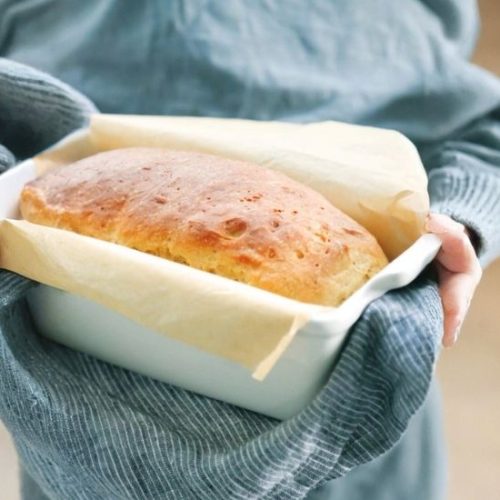
Einkorn Bread
A simple, wholesome Einkorn Bread recipe featuring ancient grain flour, natural sweeteners, and olive oil. It yields a soft, slightly sticky dough that rises twice for a flavorful, golden crust loaf. Ideal for health-conscious bakers seeking a nutritious homemade bread option.
Equipment
- 1 large mixing bowl
- 1 Wooden spoon
- 1 Standard-Size Loaf Pan
- 1 Kitchen Towel (cotton recommended)
- Measuring cups and spoons set
Ingredients
- 1 cup 230 g room-temperature water
- 2 teaspoons active dry yeast
- ¼ cup 80 g honey
- 2 tablespoons 20 g extra virgin olive oil
- 1 teaspoon salt
- 3 ½ cups 440 g all-purpose einkorn flour (see Notes for alternatives)
Instructions
- Activate the Yeast: Pour the warm water into a large mixing bowl. Sprinkle the yeast evenly over the surface. Allow it to rest undisturbed for about 5 minutes until it becomes bubbly and frothy, indicating the yeast is active and ready.
- Combine Wet Ingredients: Whisk the honey, olive oil, and salt into the yeast mixture until well blended. This mixture adds moisture, flavor, and helps with the bread’s tenderness.
- Incorporate the Flour: Gradually add the einkorn flour to the wet ingredients. Stir gently at first with a wooden spoon until the dough starts to come together but becomes too stiff to mix with the spoon alone.
- Lightly Knead the Dough: Using your fingertips, carefully fold in the remaining flour. Knead the dough gently, just enough to combine all the flour without overworking. Einkorn dough is sticky and delicate—over-kneading will toughen it, so handle it with care.
- First Rise (Proofing): Cover the bowl with a clean kitchen towel and place it in a warm spot. Let the dough rest for about 60 minutes, or until it doubles in volume. This slow fermentation allows the dough to absorb moisture and develop flavor.
- Shape the Loaf: Dust your hands lightly with flour to prevent sticking. Gently shape the risen dough into a loaf form. If the dough feels too sticky, sprinkle a little flour as needed, but avoid adding too much to keep the crumb tender.
- Second Rise: Transfer the shaped dough into a greased or parchment-lined standard loaf pan. Cover again with the towel and allow it to rise for an additional 30 minutes to puff up and fill the pan.
- Bake to Perfection: Preheat your oven to 375°F (190°C). Remove the towel and bake the bread in the center rack for approximately 35 minutes, or until the crust is a deep golden brown and the loaf sounds hollow when tapped.
- Cooling: Remove the bread from the oven and let it cool completely on a wire rack before slicing. This resting time helps the crumb set and prevents the bread from becoming gummy.
Notes
- Flour Variations: For a nuttier flavor and more fiber, substitute up to half the einkorn flour with whole wheat einkorn flour or freshly ground einkorn flour. Adjust the liquid slightly if needed.
- Handling Sticky Dough: Einkorn dough tends to be wetter and stickier than modern wheat doughs. Resist the urge to add too much extra flour, as this can make the bread dense.
- Proofing Tips: Temperature and humidity affect rise time—if your kitchen is cool, allow more time for the dough to double. Conversely, a warm, humid environment will speed up fermentation.
- Storage Advice: Store the bread wrapped in a clean kitchen towel or bread bag at room temperature for up to 3 days. For longer storage, freeze sliced bread in airtight bags.
- Honey Substitute: If you prefer, replace honey with maple syrup or agave nectar for a vegan-friendly version.